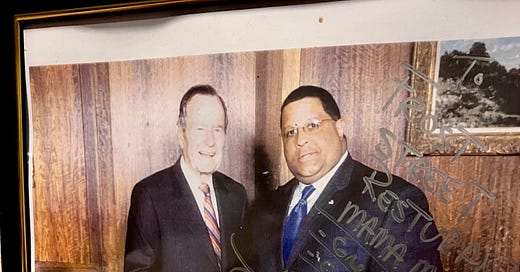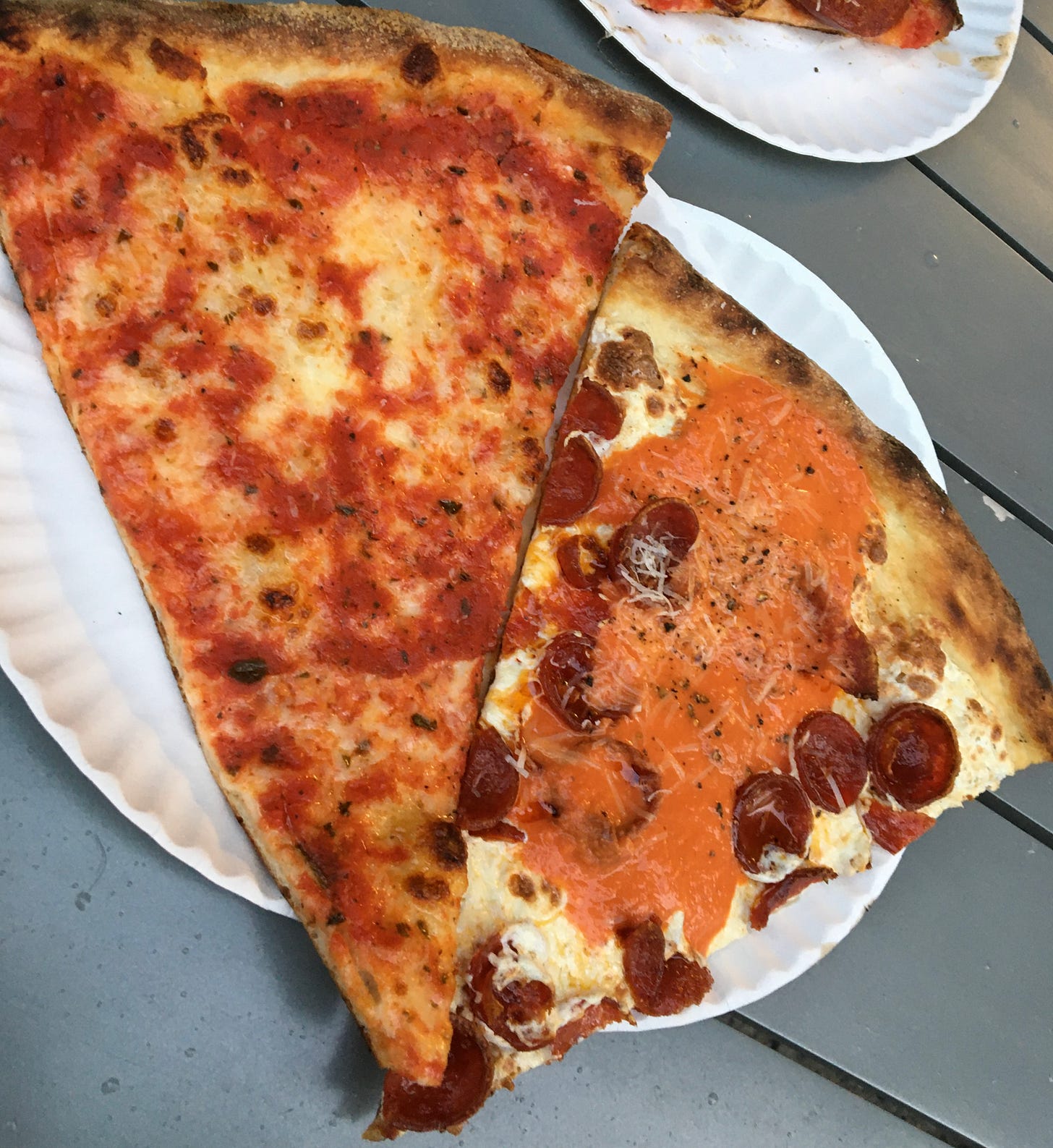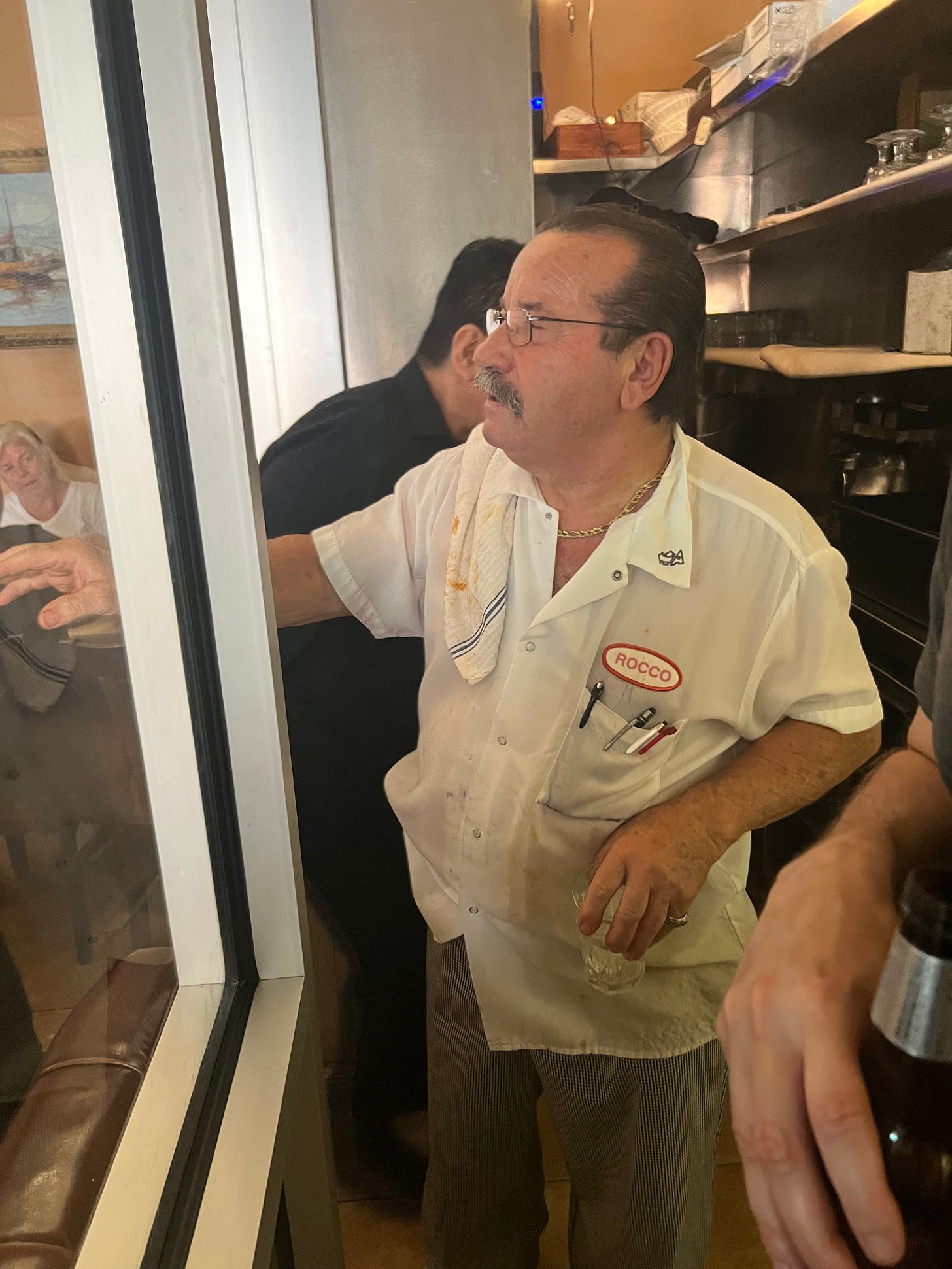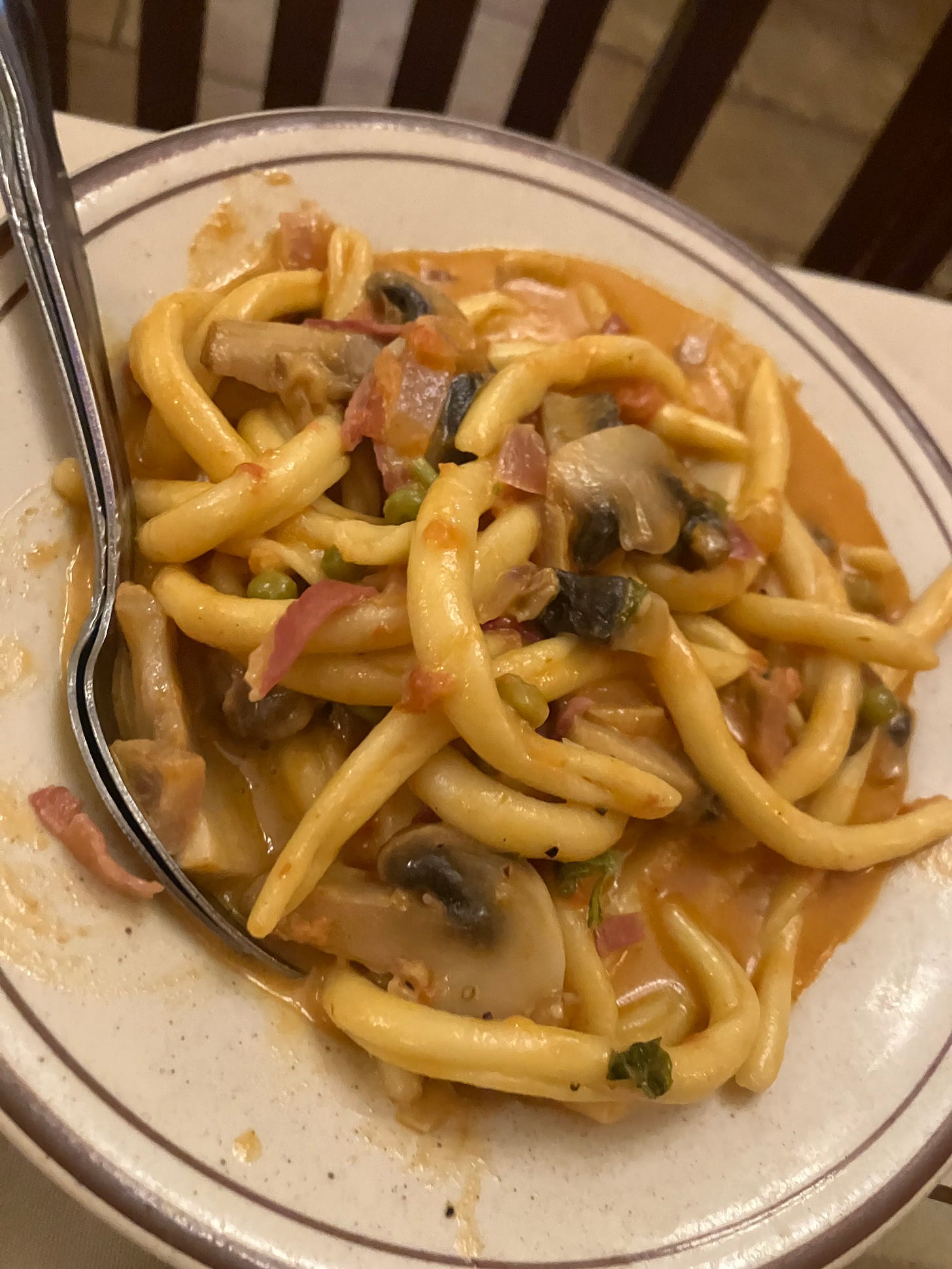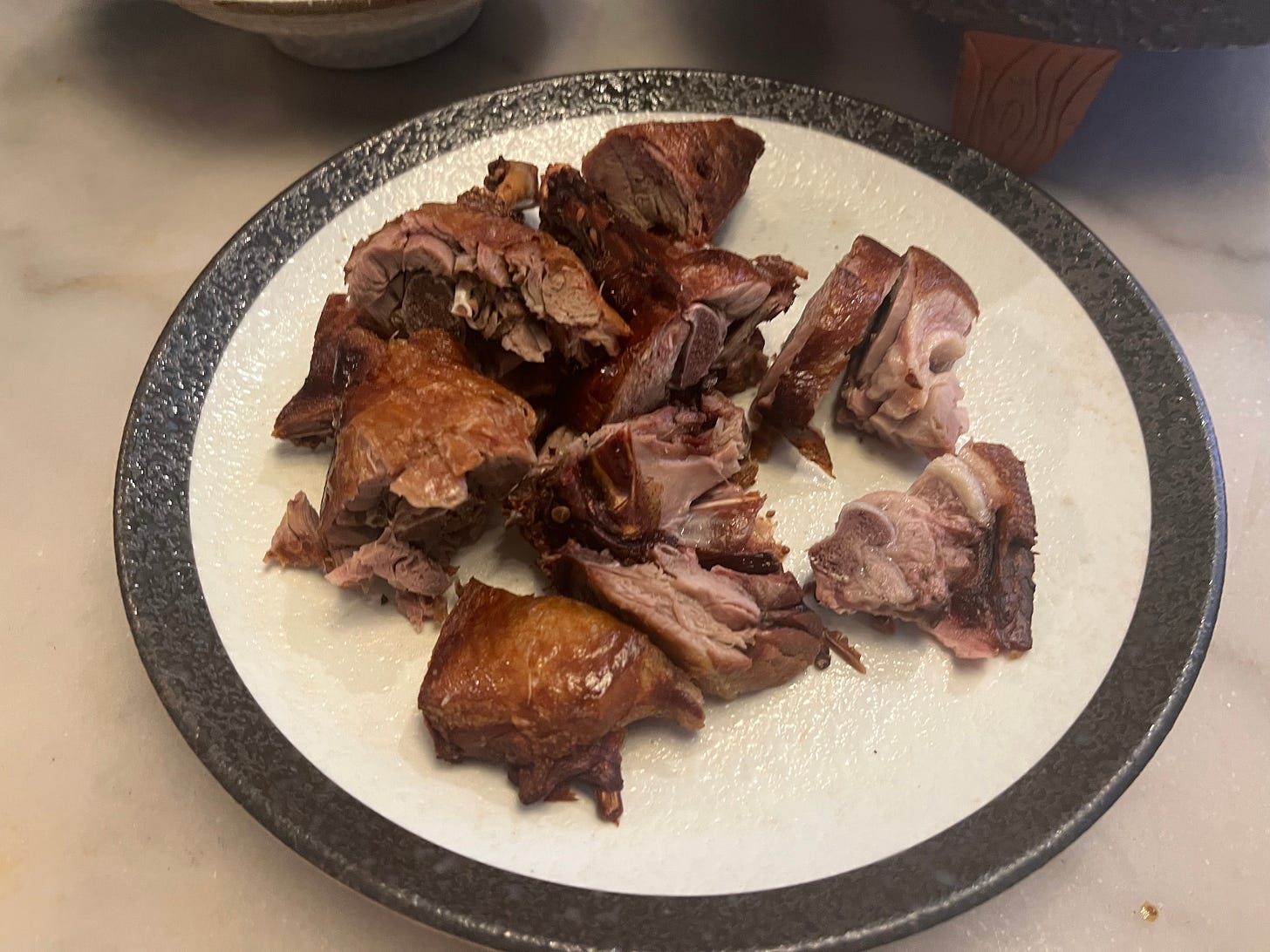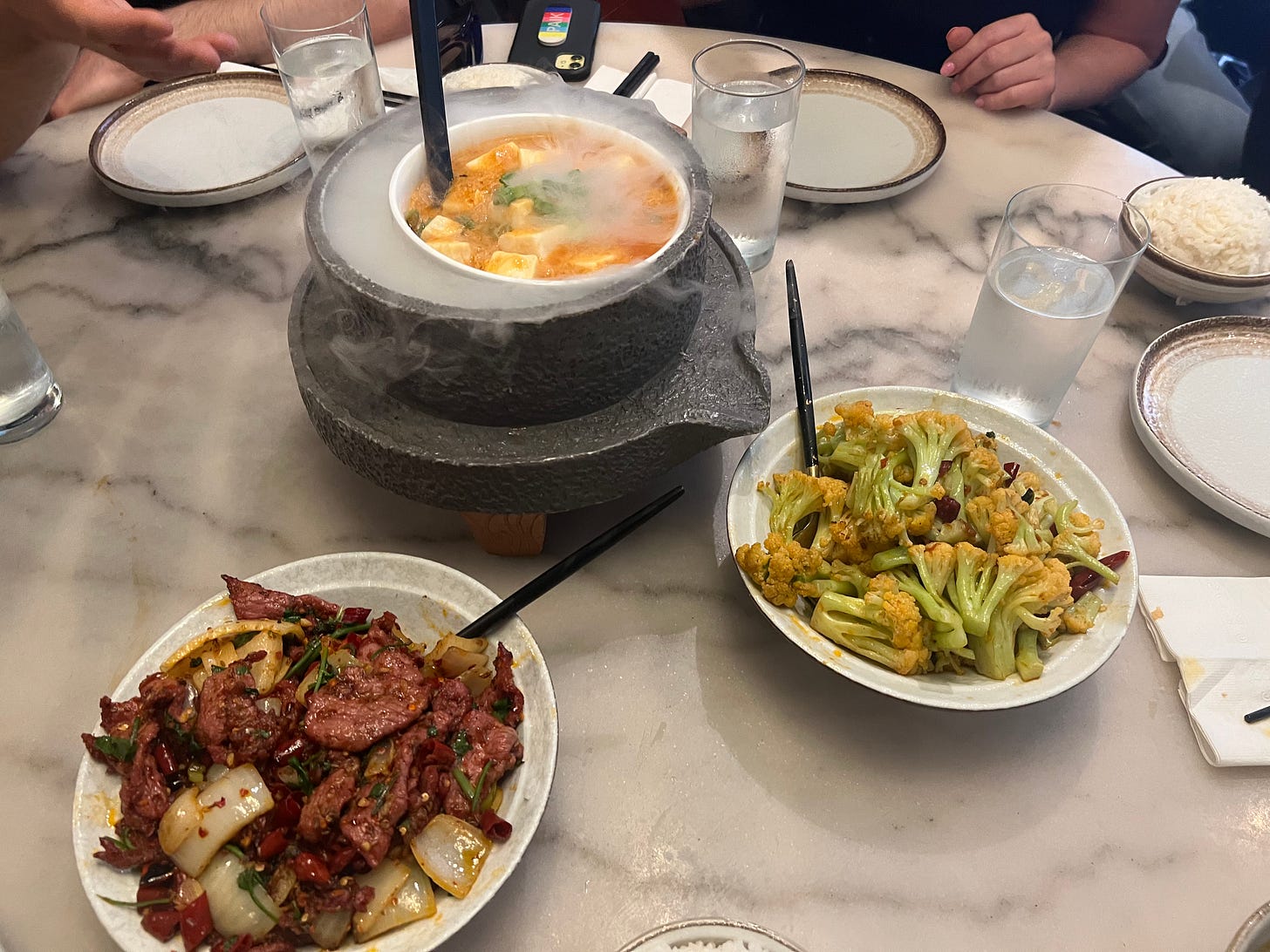The first week of June brought the announcement that Williamsburg institution Frost Restaurant would close that very weekend, followed closely by the death of pizzaiolo Andrew Bellucci at age 59.
I learned about Bellucci during year one of the pandemic while watching David Shapiro’s web series-ish Untitled Pizza Movie, which I gave up on halfway through but not before I’d learned Bellucci’s oft-retold story (’90s pizza hotshot, his rise cut short by an indictment for embezzlement, years in exile) and developed a desire to try his food. Returning to Astoria in August of 2021 for the first time since COVID hit, I went to the newly opened Bellucci’s Pizzeria and got two slices, highlighted by an incredible pepperoni-and-vodka slice (below, right) on which the sauce was ladled after it was removed from the oven.
Working the counter himself, Bellucci asked what I thought. When I effusively complimented the vodka sauce, he told me about its origins while working at Rubirosa, whose owner he unadmiringly compared to Livia Soprano. Once vodka sauce cools it de-emulsifies, rendering as a greasy mess when reheated on pizza slices; Bellucci’s solution was to put it in a nacho cheese warmer, which was on the counter. Later that night I texted the method to a friend who’d regularly read Bellucci’s posts on the pizzamaking.com forums and who himself now works at Zaza’s Pizza in Chicago. When I messaged the same friend about Bellucci’s death, he replied that if he ever opens his own restaurant, he’s going to use that technique himself. We should all be so lucky as to be so concretely influential.
Frost had been on my to-do list for years, but our final meal there was only the third time I’d been. The first was sometime in the last year-and-a-half, which I can say confidently because coverage of the Ukrainian invasion’s opening stages was on the TV the whole time (CNN in the dining room, Fox News in the kitchen). There were a few immediately lovely things about Frost, the first being that you could simply walk in early on a Friday night and be seated. (This is not the case at Williamsburg’s other Italian-American legend, Bamonte’s, where reservations are pretty essential.) The dining room was large and low-key, overlit like a senior citizen rec room, and the food was good—certainly better than at the atmospherically charming but culinarily lackluster Gene’s, for years my only reference point for Italian-American in the city. The diners were pleasingly unfashionable, middle-aged or elderly people from the neighborhood, many with brightly-colored cocktails, and very unlike the latter-day vibe at Manhattan’s now-closed Forlini’s, where a young, scene-y crowd treated what was once a normal place to eat as an unspeakably cool novelty in its final years. At Frost, you could relax.
We arrived for our last meal at 4:30 on a Friday, hoping to beat the peak dinner rush, but word was out and we stood for 45 minutes. During that time, one of the co-owners, Rocco, came out of the kitchen to a round of applause. “I’ve had 54 wonderful years in this place,” he said, then went back in to continue service.
We ordered both Italian-American and more traditionally Italian dishes—in the former category, a ricotta cavatelli with bolognese, and in the latter a dish new to me, fusilli boscaiola (above); the pasta had a fresh snap to it and a sauce of mushrooms, guanciale and cream that was inevitably very satisfying. Why close after 54 years? Apparently the restaurant, along with the multi-family residential building it’s part of, had been up for sale since August 2022—i.e., maybe for once this isn’t a story about gentrification and its casualties. (I can’t tell from the linked post if the owners of the building were also the restaurant owners.) I wish I’d made Frost part of my regular rotation years earlier, but I’m glad I still got to make it out a few times. Like it says on their surely-soon-to-be-defunct website: “Things may be changing fast in Williamsburg with its avantgarde art galleries and cool & edgy designer boutiques sprouting everywhere but Frost Restaurant is the place to go to if you want to savor a bit of the past and discover Brooklyn's roots.”
Ceremonia Bakeshop — I’m always ready to overpay for chorizo-and-egg anything. The breakfast taco form is an all-timer food for me, starting from high school runs to Austin’s long-departed Alonzo’s, whose tacos were priced 69 cents a pop so as to come out to an easy 75 cents with sales tax (three quarters, no change required; later upgraded to 93 cents a taco, or precisely a dollar with tax). That is, of course, the past as foreign country; Williamsburg’s Ceremonia Bakeshop offers a chorizo-egg-potato-cheese breakfast burrito that comes out to $17, and more if you want avocado. (“Should I get the avocado?” I asked the guy at the counter. “If you like avocado, you should. If not, no.” A kinder answer than my question deserved!) The family running Ceremonia is churning out burritos on five hot plates, no mean feat of adaptation to a space’s limitations, with exactly the loose meat, paprika-orange chorizo-and-egg mix I’m always craving. Also you can get a solid espresso while you wait, which isn’t exactly an intuitive pairing but is appreciated nonetheless.
Mockingbird Taco — Breakfast tacos in NYC were essentially non-existent when I moved here in 2004, and some initial stabs were disappointing, like the mediocre product of the much-hyped King David Tacos. (It is indeed gas-station authentic to the experience to make them all in the morning and keep them in foil under a heat lamp until sale, but it’s not ideal because after a few hours it gives the tortillas a texture that reminds me of gritty cotton candy, and at $6 a pop I’m allowed to ask for better.) NYC’s gold standard is Yellow Rose, whose chorizo-and-egg executes the platonic ideal of my aforementioned high school fixation but which makes it annoyingly difficult to get said tacos by limiting them to brunch hours on Sundays. Mockingbird Taco manages to be equally annoying in a different way—at least Yellow Rose keeps breakfast taco service going until 2 pm, but Mockingbird restricts its tacos to Wednesday through Saturday from 7 am to 11 am or “till sold out.” The bacon-and-egg one is, exasperatingly, pretty good: the tortillas are high quality, the eggs gooily soft-scrambled, the bacon thick-cut and assertively smoked. The chorizo-and-egg isn’t what I’m looking for—it’s cut up, casing-stuffed link chorizo rather than the variant I crave. Both are priced at $6, but that’s inclusive of tax and tip, and they’re pretty large—two are definitely a full meal—so fair enough.
Halal N Out — For a while now I’ve regularly passed by and been amused to see the signage for this place, whose name and logo so flagrantly rips off In-N-Out that it seems to be begging for a lawsuit and/or a novel application of fair use law. But it never occurred to me to actually step in and try it until Robert Sietsema did exactly what a food critic is supposed to do—try an un-prepossessing looking eatery and sound the klaxon if something good is found. (As opposed to what a lot of food criticism seems to be, which is ratifying the hype of the most publicity-savvy new things, which is generally true of a lot of criticism across all fields.) So, when he commended the spicy chicken sandwich here, I took note the next time I was in the area. Many people came and went with their orders while I waited ten-plus minutes for my sandwich, wondering what was taking so long. The answer was a best-case scenario: they were deep-frying two massive chicken tenders (dark meat, I think) just for me. Sietsema notes the taste of powdered cayenne; to me, the batter gave “falafel seasoning,” a novel flavor in the crowded, post-Popeye’s “we too have a chicken sandwich” sweepstakes.
ChiLi — This Sichuan place operating out of Cafe China’s former space was opened by that restaurant’s ex-employees and promptly accused by the former owners (who since re-opened Cafe China in a new location) of copycat-ing their recipes. In his dual review, Sietsema notes how completely different the restaurants’ mapo tofus are, so that doesn’t seem to be the case. Two meals at ChiLi have proven no exception to the generally high standard of Sichuan food in NYC; definitely get the wonderfully intense tea smoked duck (above, top), gnawed off roughly hacked bones. That makes it tasty but not very photogenic, for which the restaurant has compensated by serving it under a dome which, when lifted, unleashes an Instagram-friendly cloud of smoke. Also definitely get the dry pot crispy carp and the braised tofu with crab meat (above, at the top of the bottom photo, in its own cloud of Insta-friendly smoke; cumin lamb to the left below, cauliflower to the right). Previously unfamiliar to me, the braised tofu dish seems to be at every high-end-ish Chinese place that’s opened in the last two years; the lower-cost version is made with salted egg yolk instead, and the fact that the more expensive crab roe is seemingly a default says a lot about where Chinese food is headed in the city. But it’s very good, and for once I’m not complaining.
The Google Map to date.
